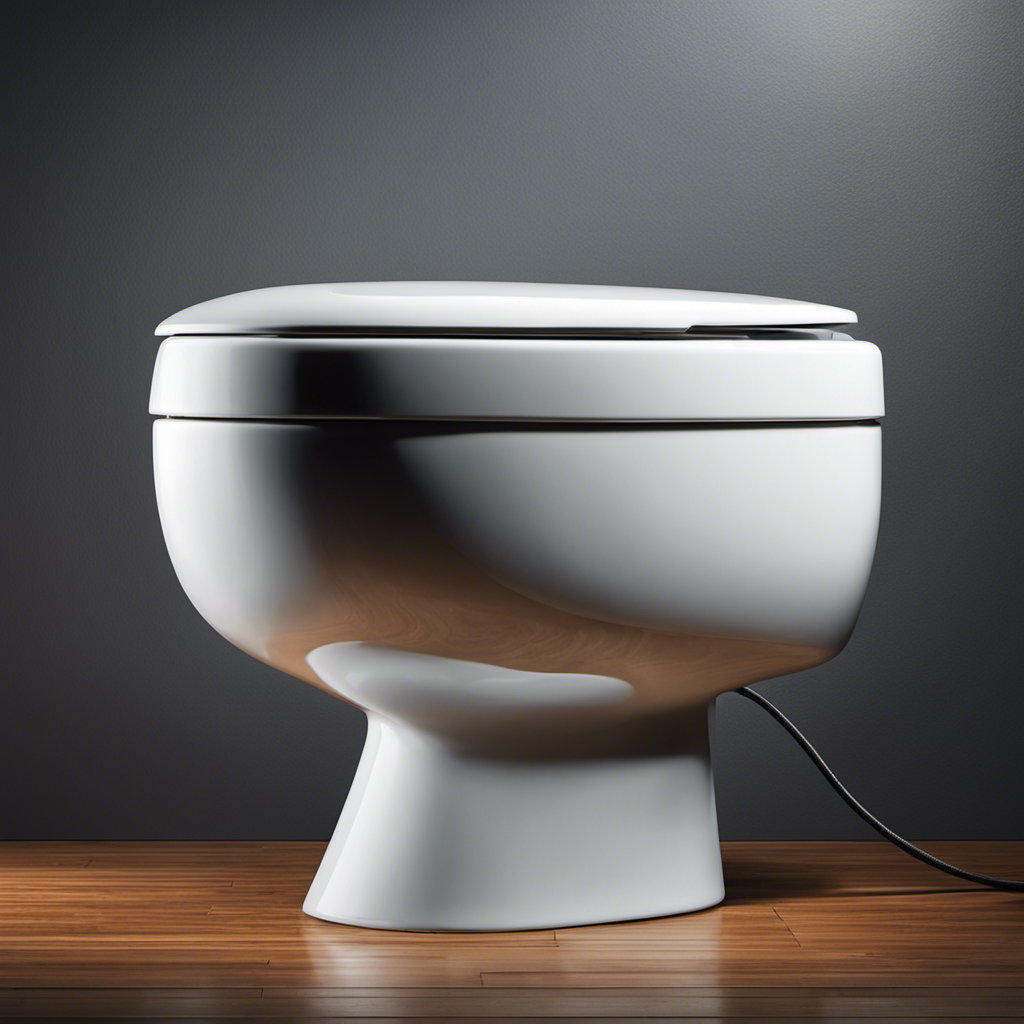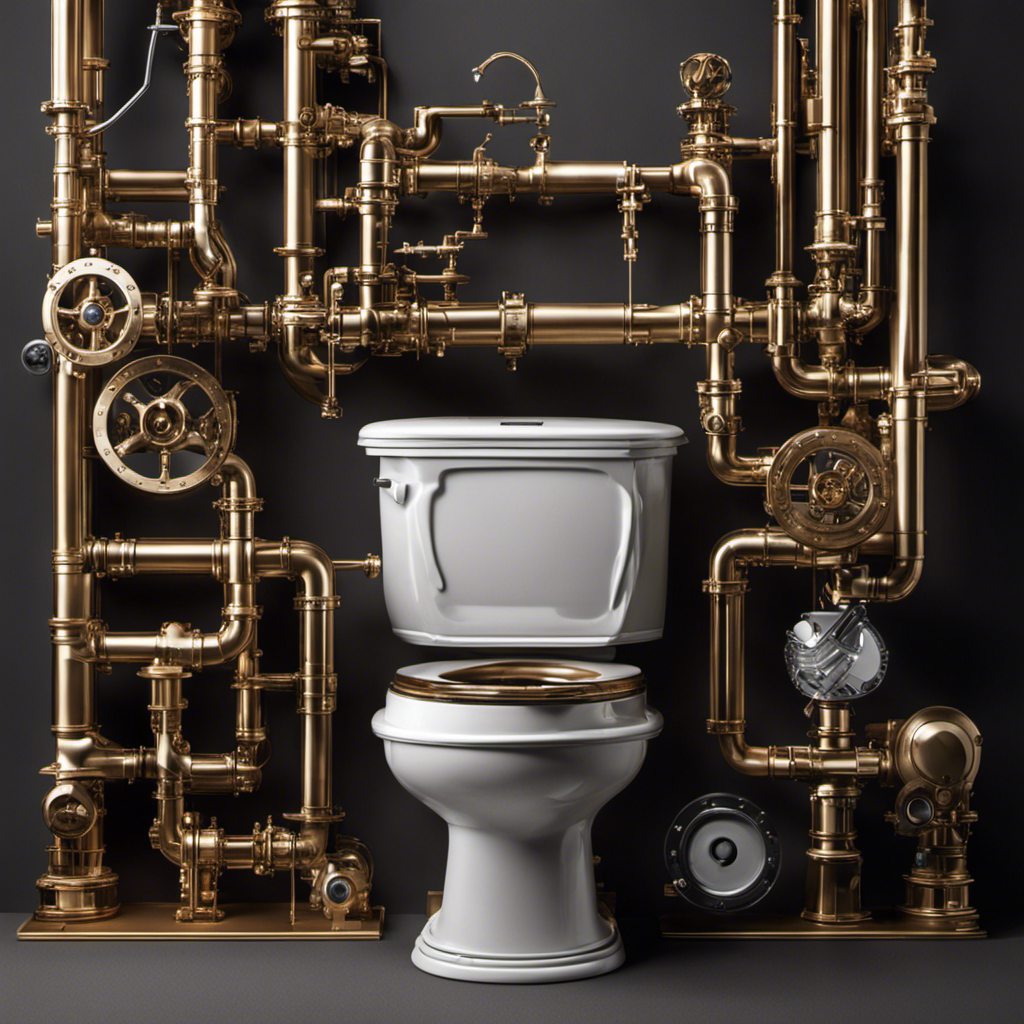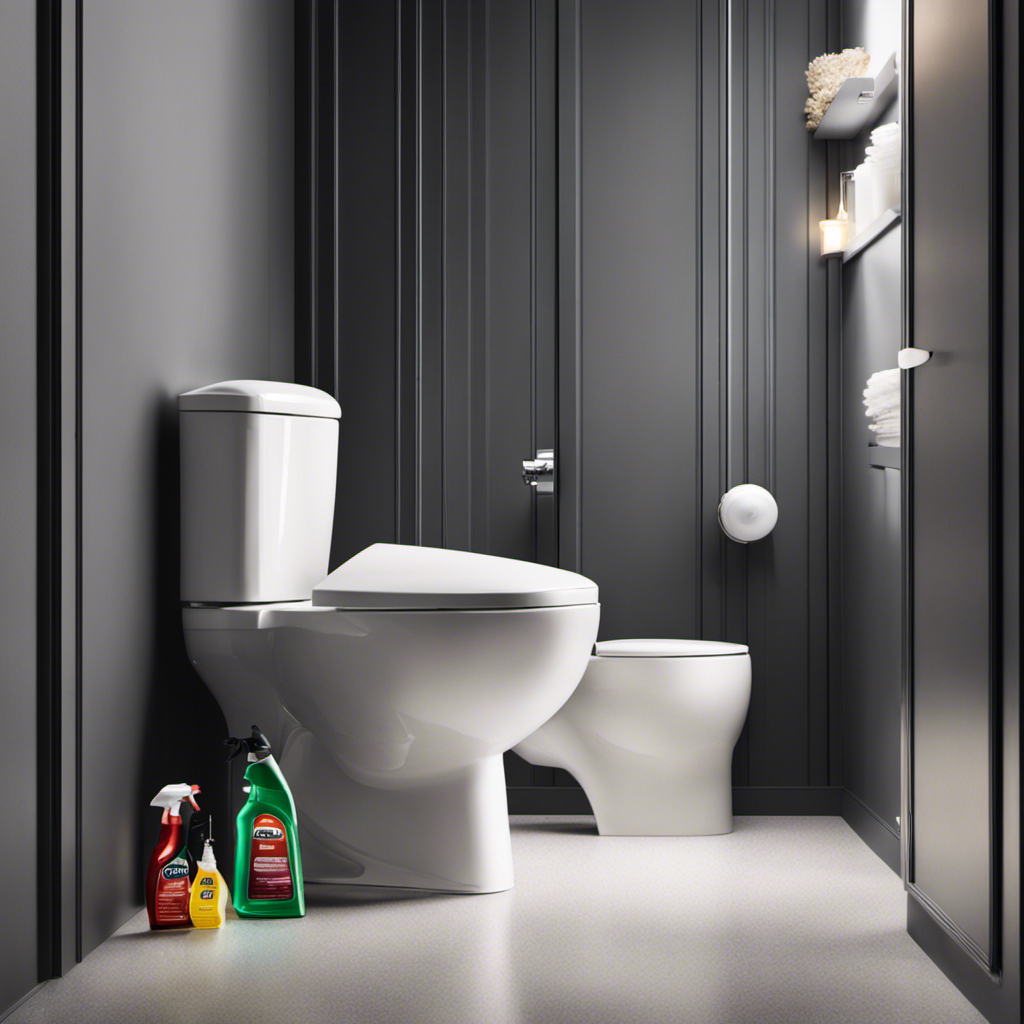I’ve been there. You flush the toilet and wait, but it seems like an eternity for the tank to fill up again. It’s frustrating, especially when you’re in a hurry.
In this article, we’ll dive into the possible causes for slow toilet filling and explore common plumbing issues that can affect the fill rate. We’ll also take a closer look at the water supply system and share some troubleshooting tips to help you fix the problem.
So, let’s get started and put an end to that slow-filling toilet once and for all.
Key Takeaways
- Possible causes for slow toilet filling include clogged or partially closed water supply valve, debris obstructing the water supply valve, insufficient water pressure, and faulty fill valve.
- Common plumbing issues affecting toilet fill rate are clogged water supply, faulty fill valve, low water pressure, blockage in the fill tube, and damaged or worn-out components.
- Troubleshooting and fixing water supply issues involve checking the water supply valve, inspecting the water supply line, cleaning the water supply valve and fill tube, regularly performing water supply maintenance, and troubleshooting plumbing problems.
- Troubleshooting and fixing fill valve issues require regular maintenance, checking for signs of damage or wear, promptly replacing the faulty fill valve, cleaning the fill valve and other components regularly, and maintaining proper water flow in the toilet.
Possible Causes for Slow Toilet Filling
One possible cause for your toilet filling slowly could be a clogged or partially closed water supply valve. The water supply valve is responsible for allowing water to flow into the toilet tank. If it becomes clogged with debris or is only partially open, it can restrict the flow of water, resulting in a slow filling toilet tank.
To check if this is the issue, locate the water supply valve, typically located near the bottom left side of the toilet. Ensure that it is fully open and not obstructed by any debris. If it is clogged, clean it out using a small brush or by flushing it with water.
If the problem persists, there may be other causes for the slow filling of your toilet tank.
Common Plumbing Issues Affecting Toilet Fill Rate
When it comes to common plumbing issues affecting toilet fill rate, there are a few key points to consider.
First, a clogged water supply can restrict the flow of water into the toilet tank, causing it to fill slowly.
Second, a faulty fill valve can also contribute to a slow fill rate, as it may not be allowing water to enter the tank efficiently.
Lastly, low water pressure can have a significant impact on the speed at which the toilet fills, as it limits the amount of water that can flow into the tank.
Clogged Water Supply
If your toilet is filling slowly, it could be due to a clogged water supply. To troubleshoot this issue, follow these steps:
-
Check the water supply valve: Make sure the valve is fully open, allowing maximum water flow to the toilet tank.
-
Inspect the water supply line: Look for any kinks, twists, or damage that may be obstructing the water flow. If you find any issues, replace the supply line.
-
Clean the water supply valve and fill tube: Sediment and debris can accumulate over time, causing blockages. Use a brush or vinegar solution to clean these components.
By regularly performing water supply maintenance and troubleshooting plumbing problems, you can prevent or resolve slow toilet filling caused by a clogged water supply.
However, if the issue persists, it may be due to a faulty fill valve, which we will discuss in the next section.
Faulty Fill Valve
The faulty fill valve can hinder the proper functioning of the toilet’s water flow. The fill valve is responsible for regulating the water level in the tank after each flush. If the fill valve is faulty, it can result in slow or inadequate water flow, leading to problems with flushing and refilling the tank.
To maintain proper water flow in the toilet, regular maintenance is crucial. This includes checking the fill valve for any signs of damage or wear, such as leaks or blockages. If you notice any issues, it is important to replace the faulty fill valve promptly.
Additionally, proper toilet maintenance involves cleaning the fill valve and other components regularly to prevent any blockages or obstructions that may hinder water flow.
Low Water Pressure
To improve the low water pressure in your toilet, you should check the fill valve for any signs of damage or wear. The fill valve is responsible for regulating the water flow into the toilet tank.
Here are three troubleshooting steps to help you address the issue:
-
Inspect the fill valve: Look for any cracks, leaks, or mineral deposits that may be obstructing the water flow. If you notice any damage, consider replacing the fill valve.
-
Clean the fill valve: Mineral deposits can build up over time and affect the water pressure. Use a vinegar solution to soak the fill valve and remove any blockages.
-
Adjust the water level: If the water level in the toilet tank is too low, it can result in low water pressure. Adjust the fill valve to increase the water level and improve the flushing power.
Understanding the Water Supply System
When it comes to the water supply system in your home, there are two key points that can often cause issues: water pressure problems and clogged supply lines.
Water pressure issues can result in weak flow or inconsistent water supply to your fixtures, while clogged supply lines can lead to reduced water flow or even complete blockages.
Understanding and addressing these two factors is crucial in maintaining a properly functioning water supply system and ensuring a steady flow of water throughout your home.
Water Pressure Issues
Have you checked if there’s a problem with your water pressure causing your toilet to fill slowly? Low water pressure can be a common issue that affects the performance of your toilet.
Here are some troubleshooting steps and solutions to address this problem:
-
Check the water pressure: Use a pressure gauge to measure the water pressure coming into your house. The ideal range is typically between 40-60 PSI (pounds per square inch). If the pressure is below this range, it may be the cause of the slow filling toilet.
-
Inspect the pressure regulator: The pressure regulator controls the water pressure in your plumbing system. If it’s faulty or damaged, it can lead to low water pressure. Consider replacing it if necessary.
-
Clean or replace the fill valve: The fill valve is responsible for regulating the water flow into the toilet tank. If it’s clogged or worn out, it can impede the filling process. Clean or replace the fill valve to improve water flow.
Clogged Supply Lines
After investigating water pressure issues, another possible cause for a slow-filling toilet is clogged supply lines. When pipes become clogged, water flow restriction occurs, resulting in reduced water pressure and slower filling times. Clogged pipes can happen due to a variety of reasons, including mineral buildup, debris accumulation, or even tree root intrusion in older plumbing systems. To address this issue, it is important to identify the location of the clog and remove it. This can be done through several methods, such as using a plumber’s snake or a high-pressure water jet. Regular maintenance and cleaning of supply lines can help prevent clogs and ensure optimal water flow in your toilet.
To better understand the impact of clogged supply lines on water flow, consider the following table:
| Causes of Clogged Supply Lines | Effects on Water Flow |
|---|---|
| Mineral buildup | Reduced water pressure and flow |
| Debris accumulation | Restricted water flow |
| Tree root intrusion | Blocked water flow |
How to Check and Adjust Water Pressure
You can easily check and adjust water pressure to ensure your toilet is filling properly. Here’s how:
-
Locate the water pressure regulator: It is usually found near the main water supply valve. Use a wrench to loosen the lock nut.
-
Adjust the water pressure: Turn the adjusting screw clockwise to increase the pressure or counterclockwise to decrease it. Use a pressure gauge to measure the pressure accurately.
-
Test the pressure: Flush the toilet and observe if it fills up properly. If the pressure is still low, there may be other issues like a clogged supply line or a faulty fill valve.
Fixing a Faulty Fill Valve
To fix a faulty fill valve, start by shutting off the water supply to your toilet.
First, locate the shut-off valve, which is usually located behind the toilet near the wall. Turn the valve clockwise to shut off the water flow.
Once the water is off, you can proceed with fixing the fill valve. One common issue with a fill valve is a misadjusted float. The float controls the water level in the tank, so if it is set too high or too low, it can cause problems with the fill valve.
Adjust the float by turning the adjustment screw or sliding it up or down, depending on the type of float you have.
Another possible cause of a faulty fill valve is a worn-out flapper. The flapper is responsible for sealing the tank and preventing water from flowing into the bowl. If the flapper is cracked or damaged, it can cause slow filling.
To replace the flapper, simply remove the old one and install a new one according to the manufacturer’s instructions.
Once you have adjusted the float or replaced the flapper, turn the water supply back on and check if the fill valve is working properly.
If the problem persists, you may need to seek professional help.
Troubleshooting the Flush Valve
The most common issue with a faulty flush valve is a weak flush. If you’re experiencing this problem, don’t worry. Here are some troubleshooting steps you can take to get your toilet flushing properly again:
-
Check for blockages: Sometimes, debris can accumulate in the flush valve, causing a slow drain. Use a plunger or a toilet auger to remove any obstructions.
-
Inspect the flapper: The flapper is a rubber seal that controls the flow of water from the tank to the bowl. If it’s worn or damaged, it can cause a weak flush. Replace the flapper if necessary.
-
Adjust the chain: The chain connecting the flapper to the flush handle should have some slack. If it’s too tight, it can prevent the flapper from fully opening. Adjust the chain length accordingly.
Preventing Future Slow Filling Issues
Now that we have addressed the issue with the flush valve, let’s discuss how we can prevent future slow filling issues in our toilets. By taking some preventive measures, we can not only save water but also maintain optimal water levels in our toilets. Here are some tips to help you prevent water waste and ensure efficient filling:
| Tip | Description | Benefits |
|---|---|---|
| Check for leaks | Regularly inspect your toilet for any leaks. A leaking toilet can waste a significant amount of water over time. | Prevents water waste and keeps water levels optimal. |
| Clean the fill valve | Sediments and debris can accumulate in the fill valve, causing it to function improperly. Clean the fill valve periodically to ensure smooth and efficient filling. | Maintains optimal water levels and prevents slow filling. |
| Adjust the water level | Check the water level in the toilet tank and adjust it if necessary. The water level should be around one inch below the top of the overflow tube. | Maintains optimal water levels and prevents overfilling. |
| Install a dual flush system | Consider installing a dual flush system that allows you to choose between a full flush and a partial flush. This can significantly reduce water usage. | Prevents water waste and promotes water conservation. |
Frequently Asked Questions
Can a Clogged Drain Affect the Filling Speed of a Toilet?
Yes, a clogged drain can affect the filling speed of a toilet. When a drain is clogged, it can cause a decrease in water pressure, resulting in a slower fill time for the toilet tank.
Is It Possible for a Faulty Flapper Valve to Cause Slow Toilet Filling?
It’s possible for a faulty flapper valve to slow down the filling speed of a toilet. The flapper valve controls the flow of water from the tank to the bowl, so if it’s not functioning properly, it can restrict the amount of water entering the tank.
Can Sediment Buildup in the Water Supply Line Lead to Slow Toilet Filling?
Yes, sediment buildup in the water supply line can lead to slow toilet filling. It can restrict the flow of water, causing low water pressure and affecting the toilet’s ability to fill quickly.
Are There Any DIY Methods to Increase the Water Pressure for Faster Toilet Filling?
There are several DIY methods for increasing water pressure in toilets. To troubleshoot slow toilet filling, check the shut-off valve, clean the fill valve or replace it, and ensure there are no clogs in the supply line.
Can a Malfunctioning Float Valve Be Responsible for Slow Toilet Filling?
A malfunctioning float valve can cause slow toilet filling. However, there are other potential causes to consider. To troubleshoot and fix a slow filling toilet, try checking the water supply line and adjusting the fill valve.
Conclusion
In conclusion, understanding the causes of slow toilet filling can help you troubleshoot and resolve the issue efficiently.
By checking and adjusting water pressure, fixing faulty fill valves, and troubleshooting the flush valve, you can restore your toilet’s fill rate and prevent future problems.
Did you know that a slow-filling toilet can waste up to 200 gallons of water per day?
Taking prompt action to fix this issue not only saves water but also helps you avoid costly repairs in the long run.










